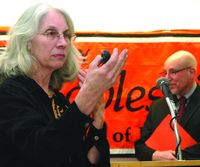Subscriptions
Menu
Advertisements
SUNY histotechnology gets a new start
2/9/2010 |
By Jim Poole |

A SUNY Cobleskill program that’s the only one of its kind in the state––and one of the few in the nation––got a new start on Friday.
College officials, business leaders and SUNY grads celebrated the return of the college’s histotechnology program and thanked Senator Jim Seward and Assemblyman Pete Lopez for bringing it back.
“This is exactly the type of offering SUNY Cobleskill is known for,” said Senator Seward. “And this fosters the relationship between education and the business community.”
Histotechnologists preserve tissue and prepare microscopic slides for pathologists for patient diagnosis and treatment.
SUNY Cobleskill’s program is the oldest in the country and one of the largest, with 16 students.
But histotechnology was omitted from a state law requiring licensing of lab technicians in 2008. The program at SUNY Cobleskill closed for a year before Senator Seward and Assemblyman Lopez engineered an amendment to the law, correcting the omission.
About 50 officials and graduates gathered in Wheeler Hall to applaud the program’s revival and its boost to students, the region and the economy.
The histotech program started up again at the beginning of this academic year.
“Pete was the real impetus for this,” said Dr. Pam Colony, director of SUNY Cobleskill’s program. “It was really a matter of educating the legislature. Pete and Jim were wonderful.”
Every SUNY Cobleskill histotech grad is employed, and the high demand speaks to the importance of the program, Dr. Colony said.
“We get calls begging for our graduates,” she said.
Dr. Luis Chiriboga agreed. A Cobleskill histotech grad, Dr. Chiriboga is an assistant professor of pathology at the NYU School of Medicine.
SUNY Cobleskill has a name in New York City health circles, Dr. Chiriboga said.
“When you see a Cobleskill kid coming through, you grab him,” he said.
Assemblyman Lopez touched on the program’s uniqueness as an economic development tool.
“Saving this program, and the opportunities for the program’s graduates, is a critical example of how government needs to work closely with the private sector to address employment and training issues,” he said.
Alicia Terry, Schoharie County’s director of planning, and Jodie Rutt, executive director of the Chamber of Commerce, both said the program’s specialized training is essential in keeping young people here as part of a skilled local workforce.
Dr. Colony agreed, adding that although there are SUNY Cobleskill histotech grads all over the country, many return to or stay in New York.
Histotechnology has a direct link to the high-tech efforts such as Luther Forest in Saratoga County, said Mike Tucker, president of the Center for Economic Growth, which includes the Capital District.
“It is Tech Valley,” Mr. Tucker said, referring to SUNY Cobleskill. “We’re all in this together.”
And praising Senator Seward and Assemblyman Lopez for their roles, he added, “Thanks for getting rid of this bottleneck.”
SUNY Cobleskill President Dr. Don Zingale added his thanks as well.
“We are so pleased that, once again, Assemblyman Lopez and Seantor Seward have brought ‘added value’ to our region,” Dr. Zingale said.
After the presentations, Dr. Colony led the audience on a tour of the histotech lab, where students were working on tissue samples and microscopic slides.









